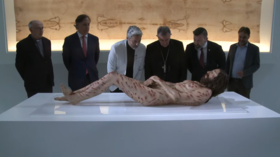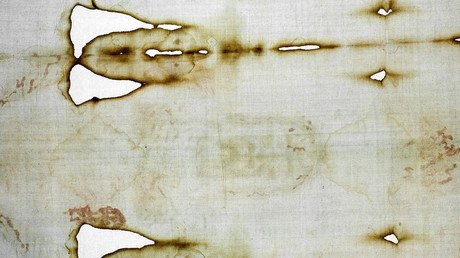Hyper-realistic Jesus put on display

An ultra-lifelike model of Jesus Christ has gone on display at Salamanca Cathedral in Spain. Made from silicone, latex, and human hair and based on data from the Shroud of Turin, the sculpture depicts Christ’s horrific wounds.
The exhibit, dubbed ‘The Mystery Man,’ opened last week, after 15 years of research by a group of artists led by curator Alvaro Blanco, the Catholic News Agency reported. Blanco’s team based Christ’s form on a study of the Shroud of Turin, a linen cloth discovered in the Middle Ages that some Catholics say is the burial shroud of Jesus himself, and others argue is an elaborate forgery.
Weighing around 75kg (165 pounds), the model depicts Jesus hunched in rigor mortis, with his shoulders bruised from carrying the cross, his body torn from being whipped by Roman soldiers, and his head bloodied from wearing the Crown of Thorns. His side is pierced and traces of nails are visible in his hands and feet.
Unlike some traditional depictions of Jesus, the model’s genitals are not omitted for the sake of modesty.
The Holy Shroud of Turin, a realistic reproduction of what Jesus Christ actually looked like (according to Holy Shroud) is presented today.From today until December you will be able to visit the exhibition in the Salamanca Cathedral. pic.twitter.com/HG95a5hBO0
— Brian McKevitt (@BMcKev) October 14, 2022
“I liked the work very much,” Bishop Jose Luis Retana of Salamanca told Vatican News. “The truth is that standing in front of what is an exact representation of how Jesus suffered and died leaves a strong impression.”
Blanco said that while Jesus “is the most represented image of all history,” nobody had previously “dared to make a hyper-realistic body like this.”
While the Shroud of Turin provides ample clues as to Jesus’ measurements, facial structure, and final resting position, the Catholic Church has neither confirmed nor refuted its authenticity. Popes went back and forth on proclaiming it genuine throughout the 14th and 15th Centuries, and the Church’s current position, explained by Pope Francis in 2013, is that the shroud is an “icon” that “invites us to contemplate Jesus of Nazareth.”
Scientific research over the years has failed to deliver any clear answers either. One team of researchers concluded in 2017 that the cloth was stained with the blood of someone who had “suffered a violent death,” only for another group of scientists to cast doubt on their conclusion a year later.
The scientific consensus since the late 1980s was that the shroud was around 700 years old, but research published this year dated it to the time of Christ’s death.














